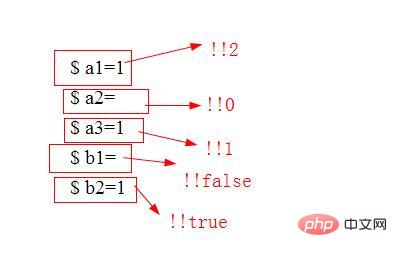How to use double NOT (!!) operator in PHP? (code example)
In PHP we often use the "!" operator. A single "!" means negation, so what is the role of double "!", that is, the double no (!!) operator? The following article will introduce you to the double no (!!) operator and introduce how to use the double no (!!) operator in PHP. I hope it will be helpful to you. [Video tutorial recommendation: PHP tutorial]

##PHP (!!) operator
In PHP the (!!) operator only returns the true value of a variable or expression. To explain in very simple terms, the first NOT operator (!) negates the expression. The second NOT operator (!) negates the expression again, yielding the previously existing truth value. The (!!) operator is returned as a Boolean function. If !! is used in an expression, the true value is true and the false value is false; the Boolean value does not change. By using the double NOT (!!) operator, it improves the readability of the code and ensures that true and false values are strictly boolean data types. Example:<?php // 声明变量并初始化它 $a1 = 2; $a2 = 0; $a3 = 1; $b1 = false; $b2 = true; // 使用双非(!!)运算符 $a1 = !!$a1; $a2 = !!$a2; $a3 = !!$a3; $b1 = !!$b1; $b2 = !!$b2; // 输出变量a的值 echo "$ a1=".$a1."<br>"; echo "$ a2=".$a2."<br>"; echo "$ a3=".$a3."<br>"; echo "$ b1=".$b1."<br>"; echo "$ b2=".$b2."<br>"; ?>

##Logical NOT (!) operator and double negation in PHP Differences between (!!) operators: The non-(!) operator is the negation of the Boolean value of the data. For example, define a Boolean value $a = True, and then impose the NOT operator on it, !$a will be False; it's about the logical NOT or negation operator.
However, the double NOT (!!) operator only returns a Boolean cast or a true value; therefore, the output of !!$ is always true.
Example:
<?php
header("content-type:text/html;charset=utf-8");
$t = 10;
// 检查条件
if ($t !== 10)
echo "这是逻辑非(!)运算符";
elseif (!!$t)
echo "这是双非(!!)运算符";
else
echo "完成";
?>Output:
这是双非(!!)运算符
The above is the entire content of this article, I hope it will be helpful to everyone's learning. For more exciting content, you can pay attention to the relevant tutorial columns of the PHP Chinese website! ! !
[Related article recommendations]
How to use the combined comparison operator () in PHP7? What is the use of the "=>" symbol in PHP? What is the use of the $$ symbol in PHP? how to use?The above is the detailed content of How to use double NOT (!!) operator in PHP? (code example). For more information, please follow other related articles on the PHP Chinese website!

Hot AI Tools

Undresser.AI Undress
AI-powered app for creating realistic nude photos

AI Clothes Remover
Online AI tool for removing clothes from photos.

Undress AI Tool
Undress images for free

Clothoff.io
AI clothes remover

Video Face Swap
Swap faces in any video effortlessly with our completely free AI face swap tool!

Hot Article

Hot Tools

Notepad++7.3.1
Easy-to-use and free code editor

SublimeText3 Chinese version
Chinese version, very easy to use

Zend Studio 13.0.1
Powerful PHP integrated development environment

Dreamweaver CS6
Visual web development tools

SublimeText3 Mac version
God-level code editing software (SublimeText3)

Hot Topics
 PHP 8.4 Installation and Upgrade guide for Ubuntu and Debian
Dec 24, 2024 pm 04:42 PM
PHP 8.4 Installation and Upgrade guide for Ubuntu and Debian
Dec 24, 2024 pm 04:42 PM
PHP 8.4 brings several new features, security improvements, and performance improvements with healthy amounts of feature deprecations and removals. This guide explains how to install PHP 8.4 or upgrade to PHP 8.4 on Ubuntu, Debian, or their derivati
 How To Set Up Visual Studio Code (VS Code) for PHP Development
Dec 20, 2024 am 11:31 AM
How To Set Up Visual Studio Code (VS Code) for PHP Development
Dec 20, 2024 am 11:31 AM
Visual Studio Code, also known as VS Code, is a free source code editor — or integrated development environment (IDE) — available for all major operating systems. With a large collection of extensions for many programming languages, VS Code can be c
 Explain JSON Web Tokens (JWT) and their use case in PHP APIs.
Apr 05, 2025 am 12:04 AM
Explain JSON Web Tokens (JWT) and their use case in PHP APIs.
Apr 05, 2025 am 12:04 AM
JWT is an open standard based on JSON, used to securely transmit information between parties, mainly for identity authentication and information exchange. 1. JWT consists of three parts: Header, Payload and Signature. 2. The working principle of JWT includes three steps: generating JWT, verifying JWT and parsing Payload. 3. When using JWT for authentication in PHP, JWT can be generated and verified, and user role and permission information can be included in advanced usage. 4. Common errors include signature verification failure, token expiration, and payload oversized. Debugging skills include using debugging tools and logging. 5. Performance optimization and best practices include using appropriate signature algorithms, setting validity periods reasonably,
 PHP Program to Count Vowels in a String
Feb 07, 2025 pm 12:12 PM
PHP Program to Count Vowels in a String
Feb 07, 2025 pm 12:12 PM
A string is a sequence of characters, including letters, numbers, and symbols. This tutorial will learn how to calculate the number of vowels in a given string in PHP using different methods. The vowels in English are a, e, i, o, u, and they can be uppercase or lowercase. What is a vowel? Vowels are alphabetic characters that represent a specific pronunciation. There are five vowels in English, including uppercase and lowercase: a, e, i, o, u Example 1 Input: String = "Tutorialspoint" Output: 6 explain The vowels in the string "Tutorialspoint" are u, o, i, a, o, i. There are 6 yuan in total
 How do you parse and process HTML/XML in PHP?
Feb 07, 2025 am 11:57 AM
How do you parse and process HTML/XML in PHP?
Feb 07, 2025 am 11:57 AM
This tutorial demonstrates how to efficiently process XML documents using PHP. XML (eXtensible Markup Language) is a versatile text-based markup language designed for both human readability and machine parsing. It's commonly used for data storage an
 Explain late static binding in PHP (static::).
Apr 03, 2025 am 12:04 AM
Explain late static binding in PHP (static::).
Apr 03, 2025 am 12:04 AM
Static binding (static::) implements late static binding (LSB) in PHP, allowing calling classes to be referenced in static contexts rather than defining classes. 1) The parsing process is performed at runtime, 2) Look up the call class in the inheritance relationship, 3) It may bring performance overhead.
 What are PHP magic methods (__construct, __destruct, __call, __get, __set, etc.) and provide use cases?
Apr 03, 2025 am 12:03 AM
What are PHP magic methods (__construct, __destruct, __call, __get, __set, etc.) and provide use cases?
Apr 03, 2025 am 12:03 AM
What are the magic methods of PHP? PHP's magic methods include: 1.\_\_construct, used to initialize objects; 2.\_\_destruct, used to clean up resources; 3.\_\_call, handle non-existent method calls; 4.\_\_get, implement dynamic attribute access; 5.\_\_set, implement dynamic attribute settings. These methods are automatically called in certain situations, improving code flexibility and efficiency.
 PHP and Python: Comparing Two Popular Programming Languages
Apr 14, 2025 am 12:13 AM
PHP and Python: Comparing Two Popular Programming Languages
Apr 14, 2025 am 12:13 AM
PHP and Python each have their own advantages, and choose according to project requirements. 1.PHP is suitable for web development, especially for rapid development and maintenance of websites. 2. Python is suitable for data science, machine learning and artificial intelligence, with concise syntax and suitable for beginners.






